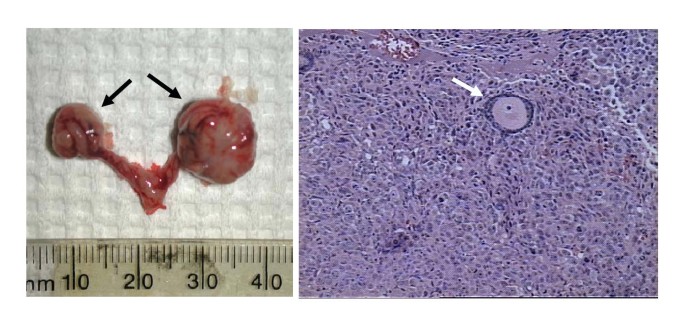ovarian tumor
- An ovarian tumor is a type of tumor that develops from the uncontrolled disordered growth of cells found within the ovary.
- The cells of the ovary contain germ cells and epithelial (skin-like) cells amongst many others, and tumors may develop from any one of these cell types.
- Many ovarian tumors are malignant.
- Some of the more common malignant ovarian tumors include teratomas (or teratocarcinomas), carcinomas, and adenocarcinomas.

Causes :
- Most seem to be caused by a complex mix of risk factors, some environmental and some genetic or hereditary. In the case of ovarian cancer, there is no known cause
- With the exception of teratomas, most cases of ovarian cancer develop in older, and of course, intact dogs.
Types of ovarian tumors arising from different cells or tissues :
- Cystadenomas / carcinomas :
- 50% of ovarian tumors
- Unilateral or bilateral
- Arises from epithelial layer of ovary and malignant tumors metastasis to para-aortic LN , kidney , omentum , liver and lungs
- They will also seed tumors throughout the abdominal cavity , resulting in carcinomatosis and formation of malignant effusion .
- Granulosa cell tumor :
- Develop from gonadostromal (sex cord) tissue of ovary
- 20% are malignant with similar metastatic pattern as seen with cystadenocarcinomas
- Unilateral
- It may be hormonally active and secrete estrogen, and comprises 50% of ovarian tumor in some reports.
- Other sex cord stromal tumors include the extremely rare and benign tumors theca and leukoma .
- Germ cell tumors :
- Dysgerminoma : arises from undifferentiated germ cells .
- They are considered to be malignant in that metastasis occurs to regional LN and other abdominal organs.
- Teratoma :
- They are usually ; but not always , benign and are often composed of 2-3 germinal layers including bone, cartilage, brain or glandular epithelium
Clinical signs :
- The signs of ovarian cancer vary depending on the type of tumor and what areas of the body it may affect. Ovarian tumors are prone to metastasizing (spreading), and some are capable of producing hormones.
- Many ovarian tumors are asymptomatic, meaning there are no clinical signs whatsoever.
- Signs may only become evident when they grow very large in size. In such cases the clinical signs can include fluid build-up in the abdomen, causing a rounded belly.
- If the tumor spreads to the lungs, fluid can build-up in the chest and cause difficulty with breathing.
- As some ovarian tumors produce estrogen and progesterone, there may be signs related to the excess of these hormones. Such signs include vulvar enlargement, vaginal discharge, persistent estrus (menstruation and heat), pyometra (pus in the uterus), lethargy, lack of appetite, weight loss, and thinning of the haircoat.
Progression of cancer
- In the majority of cases, ovarian tumors act more locally aggressive (meaning they penetrate local tissues) with a low rate of metastasis (spread to other parts of the body).
- Only in about 20-30% of cases does metastasis occur.
- Veterinarians may recommend full staging (searching for potential spread to other locations in the body) prior to surgery.. If any abnormalities are discovered, these areas may be sampled prior to, or at the time of, surgery to determine if the cancer has spread elsewhere.
Diagnosis :
- These tumors are generally difficult to diagnose initially and may be found with a physical exam or routine blood work.
- If an animal has a pyometra (infection in the uterus) or other diseases that can develop as a result of higher and abnormal hormone production, we may consider the possibility of an ovarian tumor.
- Diagnostics tests (i.e. X-rays or abdominal ultrasound)
- ovariohysterectomy